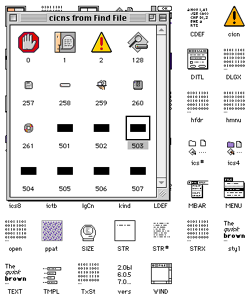
Resources represented as icons in ResEdit
ResEdit, originally developed as Resource Editor,[1] is a developer tool application for the classic Apple Macintosh, used to create and edit resources directly in the Mac's resource fork architecture. It is an alternative to tools such as the resource compiler Rez, and for the average user is generally easier to use, because it uses a graphical user interface.
Description[]
Resources on the Mac can be of many different types, and in fact any arbitrary data can be turned into a resource. While the system defines many standard formats for particular kinds of resources (e.g. an icon, or a window template), programmers are also free to define their own. ResEdit includes support for editing many of the standard types and for creating arbitrary resources with any structure a programmer might dream up.
ResEdit was one of the earliest examples of a GUI layout tool, an essential component for rapid application development. For example, the Mac OS defines a standard resource called a dialog template and a dialog items list (resource types 'DLOG' and 'DITL' respectively). In ResEdit, it is possible to simply create these types and add GUI elements to them in an almost WYSIWYG fashion, so that you can design a user interface directly as it will appear to the end user of your application. Later, the application code can create a functional dialog box using the stored resource data which will match the appearance you laid out in ResEdit. While hardly a revolutionary concept today, when ResEdit first appeared in the mid 1980s, this was a considerable innovation. ResEdit includes standard editors for windows templates ('WIND'), menus ('MENU'), dialog boxes, controls ('CNTL'), colour palettes ('clut' and 'pltt'), icons ('ICON', 'cicn', 'ICN#'), and various other standard types.
History[]
ResEdit 0.5 was distributed with brief documentation. to developers in the May 1985 Software Supplement. It included a rudimentary icon editor. Undefined resources were displayed in binary. Version 1.0 became available in the December 1985 Software Supplement.[2]
ResEdit 2.0 introduced the powerful ability to define arbitrary data structures as resources through a simple template building feature. Here, the programmer simply added elemental data types to a list to define a template (itself stored as a resource of type 'TMPL'). Such templates allowed ResEdit to build a GUI editor on the fly that could allow the entry of data and package it into a structure defined by the template. It then became a simple matter for a programmer to define a matching data structure in a chosen programming language, such as C, load the resource in a standard manner, and access the data as the defined C type. ResEdit included a number of predefined templates for many standard operating system resources that did not require a graphical editor.
ResEdit's final release was version 2.1.3 and was not ported to Mac OS X, as other tools have largely superseded it. A similar tool available from a 3rd-party developer is Resorcerer, and there is an open source Mac OS X-native resource editor called ResKnife. ResEdit will run in the Classic environment of OS X on PowerPC Macs.
References[]
- ↑ A few about boxes from vintage Mac applications by Riccardo Mori, System Folder: The Platinum Days. 2015-01-17.
- ↑ Resources and Resource Editors by Basal Gangster, The Long View. 2010-05-01.
External links[]
- ResEdit Reference for ResEdit 2.1 (PDF) at Apple
- ResEdit at Wikipedia
